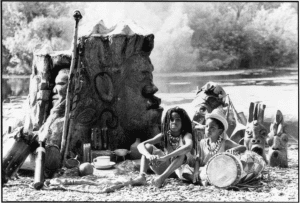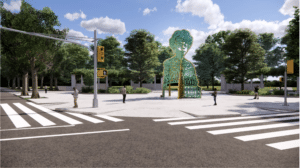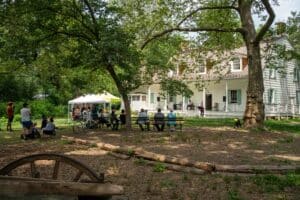Black Cultural Sites in Prospect Park
February 9, 2024
February is Black History Month! Prospect Park Alliance is celebrating this important heritage month by celebrating Black cultural sites in Brooklyn’s Backyard and Black trailblazers in Brooklyn’s history.
The Drummer’s Grove—A Prospect Park Tradition
In the 1960s, an Afro-Caribbean community emerged just east of Prospect Park in the neighborhoods of Flatbush, East Flatbush and Crown Heights, now known as “Little Caribbean.” In 1968, some members of the community began to meet weekly at the southeastern corner of Prospect Park for a drum circle. Calling themselves the Congo Square Drummers, they came together in Prospect Park “to rehearse, and just to play and rejoice,” says Abiodun McCray, one of the group’s founders. Recalling African ancestors who brought their musical traditions to the Caribbean in the 17th century, this was a way for the Congo Square Drummers to celebrate community and remember home in the midst of the African Diaspora.
Over the years, the drum circle grew, and in 1997 Prospect Park Alliance added seating to the area and gave it the name of Drummer’s Grove, and the area was restored by the Alliance in 2021 as part of its ReNew Prospect Park initiative. Today the beat goes on in Drummer’s Grove, pictured above, and it continues to be a place where anyone can stop by on a Sunday during the warmer months to play, dance, or simply enjoy the music.

Archival image depicting two children sitting by the Bazile sculpted tree surrounded by drums and other Haitian artifacts. c. Prospect Park Alliance Archives
The Sacred History of Gran Bwa
Did you know that Gran Bwa, a sacred Haitian gathering spot, is located next to Prospect Park’s Lake?
As a part of the 20th-century wave of Caribbean immigrants to Brooklyn, many Haitians settled in Little Caribbean, one of whom was Deenps Bazile. In the 1980’s, Bazile was walking through Prospect Park when he felt spirits instructing him to carve a tree trunk next to the Lake. Bazile sculpted a large human head, two small human faces, a lion and a legba (a Haitian Vodou spirit) in the tree stump. This sculpture sparked the use of the area by the Haitian community, and it came to be named after Gran Bwa, the Haitian Vodou spirit associated with trees, plants and herbs. Although the sculpture is no longer in the park, its site continues to be an important gathering spot for the Haitian community.
The largest celebration at Gran Bwa, called Bwa Kayiman, happens annually in August. At this ceremony, participants memorialize the Haitian revolution—which propelled it to become the first black nation to attain independence from their enslavers—and nourish Haitian Vodou spirits. Says Makini Armand, “Gran Bwa is a place to experience the healing power of nature and community, for us to restore ourselves through experiences that bond us with one another and with the natural community around us… it’s an important part of our cultural background to keep families together, and preserve the Haitian heritage and keep the culture alive.”
See a video of the annual celebration in Prospect Park, courtesy of CityLore on YouTube.

Virtual rendering of Shirley Chisholm monument design at Parkside entrance. c. O. Jeyifous + A. Williams
Shirley Chisholm, Brooklyn Trailblazer
A local hero, Shirley Chisholm was born in Brooklyn to Barbadian parents. She spent her childhood in Barbados but returned to Brooklyn at age ten and lived much of her life in Bed Stuy, to the northeast of Prospect Park. Chisholm was the first Black Congresswoman in U.S. history, and both a leader and an advocate for residents of Brooklyn and the country at large. Her notable achievements in Congress included working to expand access to food stamps, helping to pass Title IX and extending minimum wage requirements to domestic workers. In 1972, Representative Chisholm became the first Black major-party candidate to run for President of the United States. True to her famous slogan, “unbought and unbossed,” Chisholm refused to abandon the interests of her constituents, no matter what establishment politicians did to intimidate her or mitigate her efforts.
Two tributes to Chisholm and her legacy are coming to Brooklyn’s Backyard! The design of the Shirley Chisholm monument at the Parkside and Ocean Avenue entrance to Prospect Park will pay homage to Chisholm. Additionally, the Shirley Chisholm Welcome Center, made possible by NYC Council funding, will transform a former maintenance building at the Parkside and Ocean Ave Entrance of the park into a space that complements the new Shirley Chisholm monument at this entrance to the park. Celebrate Shirley Chisholm’s impact this Black History Month and share your feedback on ways the new Welcome Center’s design can honor Chisholm’s legacy. Take Prospect Park Alliance’s online survey to help shape the design of the Welcome Center.

The newly restored Lefferts Historic House. c. Obed Obwoge
Lefferts Historic House
Prospect Park Alliance has launched the ReImagine Lefferts Initiative to re-envision the mission and programming of the Lefferts Historic House museum to focus its interpretation and programming on exploring the lives, resistance and resilience of the Indigenous people of Lenapehoking, whose unceded ancestral lands the park and house rests upon, and the Africans enslaved by the Lefferts family. The re-imagining of the museum has been accompanied by the restoration of the Lefferts Historic House itself, which can be seen in completion in the above image.
The Alliance seeks to engage the public in thoughtful dialogue about the legacy of enslavement and the exploitation of marginalized communities in Brooklyn and beyond. To accomplish this work, the Alliance has been collaborating with descendant and neighboring communities, culture bearers, scholars, artists, civic leaders and museum professionals to create content that will support the museum’s new focus and deepen our relationships with these communities through active conversation and collaboration.
By centering the narratives at the museum on these legacies of dispossession, enslavement and oppression in Brooklyn, while also highlighting stories of resistance, resilience and joy, we seek to create a safe space for engaging with our collective past as well as contemporary issues affecting our community today. Learn more and see upcoming programming at Lefferts Historic House: prospectpark.org/lefferts